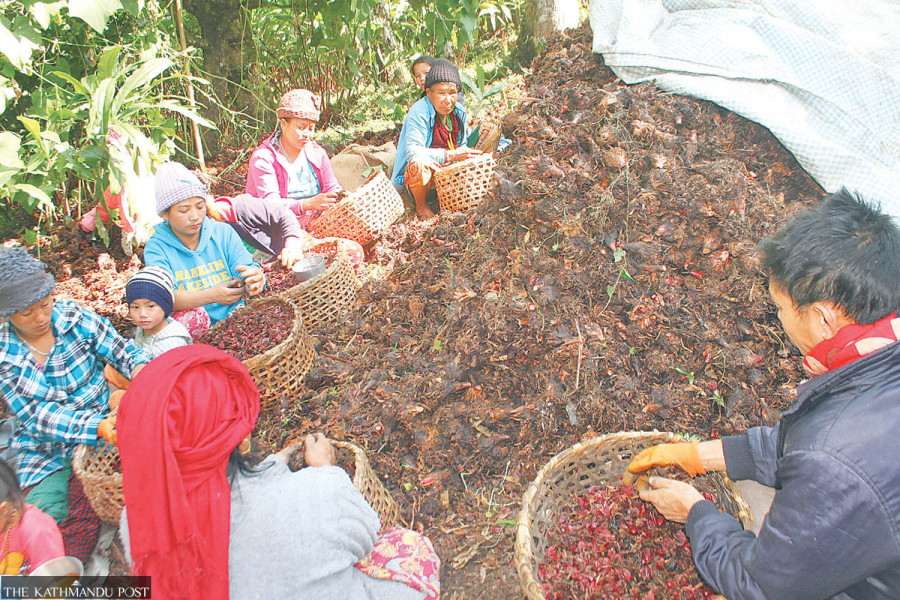Money
Large cardamom price recovers to Rs2,075 per kg
Prices are expected to rise further, but since farmers have already sold their cash crops, they will receive little benefit.
Laxmi Gautam
The price of large cardamom, one of the most valuable spices in the world, has recovered from a drop. However, the rising prices will bring little to no benefits for the farmers who have sold their produce to traders.
According to the Federation of Large Cardamom Traders, the price reached Rs2,075 per kg in the first week of March, after falling to Rs2,000 per kg at the end of January from Rs2,150 per kg in the first week of January.
Known as Alaichi, large cardamom is one of Nepal's biggest export crops.
It is harvested from mid-August to mid-November.
On Tuesday, the spice fetched Rs2,075 per kg in Birtamod, Jhapa, a key trading hub in eastern Nepal.
Spice is a key source of income for farmers in eastern hill districts. The hilly districts of Koshi province are key alaichi-producing areas. Quality is one of the determinants of the price.
The high-quality crop is being traded at Rs2,075 per kg, while the medium quality fetches Rs2,050 per kg, and the normal quality sells for Rs2,025 per kg, said Khem Adhikari, a large cardamom trader in Phidim.
At the start of the harvest season, the spice could be bought for as low as Rs1,250 per kg.
Farmers say that despite a sharp rise in prices, they normally don’t reap the benefits.
“We do not benefit from the rise in price after February,” said Yam Kurumbang, a farmer in Phalelung rural municipality ward 8. Farmers normally sell their produce early to meet their needs.
Large cardamom traders said that the price is determined by the international market. “If the commodity’s demand increases in countries like India, and Bangladesh, the price also increases. If the demand declines, the price falls,” said Deepak Nepal, a large cardamom trader who is a central member of the Federation of Nepalese Chambers of Commerce and Industry.
“The price has increased because farmers in Sikkim, India and Bhutan witnessed low output this year,” he said.
The federation has been expecting the price to breach the 2014 level this year due to low output and high international demand. In 2014, large cardamom hit an all-time high of Rs2,500 per kg.
The large cardamom output dropped by 60 percent year-on-year due to drought and pest problems in the key producing areas, according to the association.
Nepal is the largest producer of large cardamom, accounting for 68 percent of the global production, followed by India and Bhutan.
The spice is grown in Sikkim, Darjeeling and Bhutan. Large cardamom was introduced in Ilam from Sikkim in 1865.
Ilam, Panchthar, Taplejung, Sankhuwasabha, Tehrathum, Bhojpur and Dhankuta districts are the major large cardamom-producing districts in Nepal.
India is the biggest buyer of Nepal’s large cardamom, absorbing 99 percent of its exports. The spice is re-exported to Pakistan and the Middle East where it fetches high prices because of local preference for the Nepali product.
Pakistan is the largest importer of large cardamom, purchasing roughly 60 percent of India’s large cardamom exports. Large cardamom pods are used by the local Muslim community in biryani, a popular dish, as a symbol of prosperity and wealth.
“As the prices are determined by global markets, farmers are compelled to sell the spice at whatever price they are offered by the Nepali traders,” said Ganesh Pokharel, former president of the Large Cardamom Farmers Association in Panchthar.
“There is no practice to fix the minimum support price of large cardamom like ginger and broom grass. As a result, farmers must sell the produce at the price fixed by the traders.”
Traders, however, said that since it's a premium cash crop with global value and demand, prices keep fluctuating, so the minimum support price is not workable.
Birendra Yungya, a farmer in Panchthar, said they harvest, process and store the crop in November. Only a few farmers keep the stock hoping that the price may rise in the offseason or in March.
According to farmers, most sell their crops immediately after the harvest because they lack money to meet their daily household expenses.
Large cardamom is used as a spice, it is also used in biscuits and bakery products, fragrance oil and alcohol.
In Nepal, Singhadurbar Vaidyakhana and other ayurvedic medicine manufacturers prepare medicine using large cardamom.
According to the Department of Customs, Nepal exported 3,183 tonnes of large cardamom worth Rs4.44 billion in the first seven months of the current fiscal year ended in mid-February.
The country exported 9,990 tonnes of large cardamom worth Rs8.27 billion in the last fiscal year 2022-23 ended in mid-July.




 7.12°C Kathmandu
7.12°C Kathmandu















